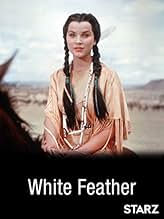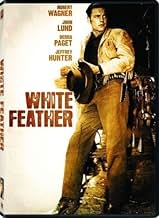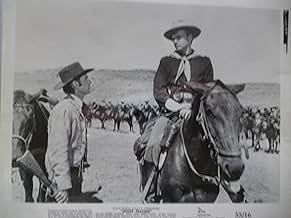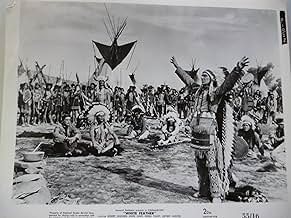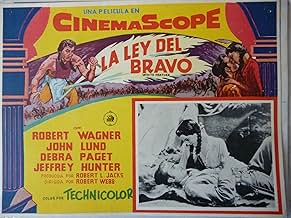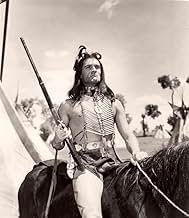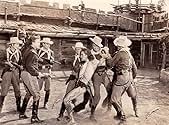CALIFICACIÓN DE IMDb
6.4/10
1.2 k
TU CALIFICACIÓN
Agrega una trama en tu idiomaIn 1877 Wyoming, during the peace negotiations between the Cheyenne and the USA, an Indian girl falls in love with a land surveyor, causing the ire of her Cheyenne fiance.In 1877 Wyoming, during the peace negotiations between the Cheyenne and the USA, an Indian girl falls in love with a land surveyor, causing the ire of her Cheyenne fiance.In 1877 Wyoming, during the peace negotiations between the Cheyenne and the USA, an Indian girl falls in love with a land surveyor, causing the ire of her Cheyenne fiance.
- Dirección
- Guionistas
- Elenco
Noah Beery Jr.
- Lt. Ferguson
- (as Noah Beery)
Iron Eyes Cody
- Indian Chief
- (sin créditos)
- Dirección
- Guionistas
- Todo el elenco y el equipo
- Producción, taquilla y más en IMDbPro
Opiniones destacadas
White Feather is out of Panoramic Productions, it's directed by Robert D. Webb and stars Robert Wagner, Debra Paget, John Lund, Eduard Franz & Jeffrey Hunter. It's adapted from a John Prebble story by Delmer Daves & Leo Townsend. It was filmed in Durango, Mexico, with Lucien Ballard on cinematography duties (CinemaScope/Technicolor) and Hugo Friedhofer provides the score. Plot centres around the peace mission from the US cavalry to the Cheyenne Indians in Wyoming during the 1870s, but problems arose because a few of the Cheyenne refused to leave their hunting grounds.
One of the few 1950s Westerns to show sympathy towards the Indian plight, White Feather is a well intentioned and well executed movie. It suffers a little from familiarity with Broken Arrow (1950), where Delmer Daves had directed James Stewart and Debra Paget thru a similar script to the one that's now in front of Wagner and Paget; and lets face it-Wagner is no Jimmy Stewart- and Robert Webb is no Delmer Daves-but there's more than enough good here to lift it above many other liberal Westerns.
Away from the endearing and emotive story (and it is as the Cheyenne are forced out of Wyoming by the Federals), the film also boasts high points for the Western fan to gorge upon. It's gorgeously shot in CinemaScope by Ballard, a first class lens-man in the genre, and Friedhofer's score is pulsating, evocative and in tune with the tone of the tale. Also of note is that these Native Americans aren't caricatures or pantomime Indians. They may be being played by white actors (Hunter & Franz do especially good work), but they feel real and come out as the human beings they were. In fact the whole movie looks convincing.
There's some missteps along the way; such as Wagner over acting and having a voice that's sounds out of place in the Wild West, while the romantic angle (Paget is so beautiful here who could not fall in love with her?) does at times threaten to clog up the narrative. But these things don't hurt the film. On the flip side there's the smooth pacing of the piece, it's only when the tense and exciting climax has arrived that you realise how well the slow burn first half was handled. And Webb may well be a second unit director in all but name here, but his construction of the scenes with hundreds of extras is top notch work.
A fine and under seen Western that is based on actual events and doesn't over egg its pudding. 7/10
One of the few 1950s Westerns to show sympathy towards the Indian plight, White Feather is a well intentioned and well executed movie. It suffers a little from familiarity with Broken Arrow (1950), where Delmer Daves had directed James Stewart and Debra Paget thru a similar script to the one that's now in front of Wagner and Paget; and lets face it-Wagner is no Jimmy Stewart- and Robert Webb is no Delmer Daves-but there's more than enough good here to lift it above many other liberal Westerns.
Away from the endearing and emotive story (and it is as the Cheyenne are forced out of Wyoming by the Federals), the film also boasts high points for the Western fan to gorge upon. It's gorgeously shot in CinemaScope by Ballard, a first class lens-man in the genre, and Friedhofer's score is pulsating, evocative and in tune with the tone of the tale. Also of note is that these Native Americans aren't caricatures or pantomime Indians. They may be being played by white actors (Hunter & Franz do especially good work), but they feel real and come out as the human beings they were. In fact the whole movie looks convincing.
There's some missteps along the way; such as Wagner over acting and having a voice that's sounds out of place in the Wild West, while the romantic angle (Paget is so beautiful here who could not fall in love with her?) does at times threaten to clog up the narrative. But these things don't hurt the film. On the flip side there's the smooth pacing of the piece, it's only when the tense and exciting climax has arrived that you realise how well the slow burn first half was handled. And Webb may well be a second unit director in all but name here, but his construction of the scenes with hundreds of extras is top notch work.
A fine and under seen Western that is based on actual events and doesn't over egg its pudding. 7/10
White Feather is a combination of the plots of both Broken Arrow and Cheyenne Autumn. It's the story of a romance between Robert Wagner and Indian princess Debra Paget set against the background of the surrender of the Cheyenne nation to the white man.
Wagner is part of delegation sent to the Cheyenne chief Eduard Franz to negotiate a treaty with the Cheyenne. Although Franz's son Jeffrey Hunter is for no surrender at any price, he and Wagner become friends. Wagner becomes more than friends with Hunter's sister Paget, something that arouses the old jealous green eye in Hugh O'Brian, an Cheyenne warrior who figures Paget's his.
Paget's not going to find it easy in the white world in any case. The post sutler Emile Meyer's not liking Indians in any case and even though his daughter Virginia Leith becomes friends with Paget, she's got a thing for Wagner herself.
White Feather is a sympathetic portrayal of the Cheyenne in the last days of a proud warrior nation. Best in the cast is Jeffrey Hunter, the man who won't give in and most of all won't surrender his pride.
John Lund as the post commander and Milburn Stone the civilian treaty negotiator are in the cast as well. White Feather is a fine western that does not get near enough acclaim.
Wagner is part of delegation sent to the Cheyenne chief Eduard Franz to negotiate a treaty with the Cheyenne. Although Franz's son Jeffrey Hunter is for no surrender at any price, he and Wagner become friends. Wagner becomes more than friends with Hunter's sister Paget, something that arouses the old jealous green eye in Hugh O'Brian, an Cheyenne warrior who figures Paget's his.
Paget's not going to find it easy in the white world in any case. The post sutler Emile Meyer's not liking Indians in any case and even though his daughter Virginia Leith becomes friends with Paget, she's got a thing for Wagner herself.
White Feather is a sympathetic portrayal of the Cheyenne in the last days of a proud warrior nation. Best in the cast is Jeffrey Hunter, the man who won't give in and most of all won't surrender his pride.
John Lund as the post commander and Milburn Stone the civilian treaty negotiator are in the cast as well. White Feather is a fine western that does not get near enough acclaim.
As a "Western movie" buff, I am surprised that this film is not more familiar to aficionados of the genre. It is a near epic, classical film.
Of course, it suffers from the usual defect common to Westerns made in this era: The Native American leads are played by white actors and there isn't adequate time to fully develop all of the characters.
Still, it is a magnificent film. It has elements of Shane, which was made several years before, and of The Searchers, which was made a year after.
The sweep and the grandeur are very reminiscent of John Ford films. No expense was spared in cinematography, locations, and the number of extras that were employed. Hundreds of Native Americans were employed, including women and children of all ages. The number of mounted cavalry approximate the size of a cavalry regiment. There weren't that many mounted soldiers in John Ford's cavalry trilogy. And, it was all achieved without the aid of computer graphics.
The dialog is realistic and the story, itself, is based on a true incident. A young Robert Wagner is very believable and likable in his solid, understated role.
This film is enormously enjoyable. I remember seeing it in the 1950s at a drive-in theater, and if only I could do so again!
Of course, it suffers from the usual defect common to Westerns made in this era: The Native American leads are played by white actors and there isn't adequate time to fully develop all of the characters.
Still, it is a magnificent film. It has elements of Shane, which was made several years before, and of The Searchers, which was made a year after.
The sweep and the grandeur are very reminiscent of John Ford films. No expense was spared in cinematography, locations, and the number of extras that were employed. Hundreds of Native Americans were employed, including women and children of all ages. The number of mounted cavalry approximate the size of a cavalry regiment. There weren't that many mounted soldiers in John Ford's cavalry trilogy. And, it was all achieved without the aid of computer graphics.
The dialog is realistic and the story, itself, is based on a true incident. A young Robert Wagner is very believable and likable in his solid, understated role.
This film is enormously enjoyable. I remember seeing it in the 1950s at a drive-in theater, and if only I could do so again!
Good Western , considered one of the first Hollywood films to side with the Indians . 1887 Wyoming , this is the story of a complex peace carried out by the Natives : Sioux , Arapahoes , BlackFoot and the US government . But a tribe resists the complete pacification : The Cheyenne . As a twisted and troublesome relationship takes place between the American cavalry commanded by Col. Lindsay from Fort Laramie : John Lund and the Cheyenne Indians led by Broken Hand ; while crooks settlers and mean traders thwart peace . A civilian surveyor : Robert Wagner attempts to make up , as he sets out to find true peace among feuding White men and Indians . Later on , he befriends a Cheyenne chief , Broken Hand: Eduard Franz , and his son Little Dog : Jeffrey Hunter and subsequently falls for his daughter Appearing Day : Debra Paget. But things go wrong when appears the jealous suitor : Hugh O'Brian, causing a merciless vengeance.The fate of the West lay in their hands , beyond any Indian adventure ever filmed , for this was the hour of decision and the last and deadly period of the Indian wars .
The picture is acclaimed along with "Broken Arrow" like the first to deal the Indian people with justice and understanding .The movie set during the 1870s is plenty of emotion , drama , romance , go riding , fights , and spectacular outdoors . The film contains enjoyable depiction about Indian habits as it was actually .A young Robert Wagner gives an acceptable acting as a surveyor whose mission is threatened when falls for the chief's daughter. She is played by the gorgeous Debra Paget interpretating a similar role to Broken Arrow. Both of whom are supported by Jeffrey Hunter who played along with Robert Wagner in "The true story of Jesse James" and "A Kiss before Dying .Furthermore , an agreeable support cast , such as : Eduard Franz as Indian chief , Hugh O'Brian as the angry fiance whose ire causes a relentless revenge , Noah Beery Jr as Lt. Ferguson , Emile Meyer , Milburn Stone and Iron Eyes Cody who played a number of Indian roles ; however , being Italian origin . Evocative and imaginative musical score by Hugo Friedhofer who also composed Broken arrow. It displays a colorful and evocative cinematography by Lucien Ballard , Peckinpah's ordinary cameraman, being shot on location in Fort Laramie , Wyoming , actual Fort at centre of events and activities portrayed and in Durango , Mexico .
The motion picture was well directed by by Robert D Webb. He was a fine craftsman and expert professional who produced and directed all kinds of genres as Cinema as TV episodes. He began working as an assistant director and second unit director in titles as Ramona, Lloyd of London , Seventh heaven , Maryland or Just around the corner. Being his his film debut :The Caribbean mystery ; from now on , he made several cinematic genres . As he realized Westerns such as : The proud ones , The Jackals ; Adventures: Pirates of Tortuga , Seven cites of gold , The way to the gold ; Film Noir : The Cape town affair , The Spiders , The Caribbean mystery ; Warlike : The glory brigade , 7 Women from hell ; and Sci-Fi : On the three hold of space . Although he also made some documentary , shorts, and Telefilms and TV episodes , such as: Temple Houston , Daniel Boone . Rating : 7 .Enjoyable Indian fare that will appeal to Western fans .
The picture is acclaimed along with "Broken Arrow" like the first to deal the Indian people with justice and understanding .The movie set during the 1870s is plenty of emotion , drama , romance , go riding , fights , and spectacular outdoors . The film contains enjoyable depiction about Indian habits as it was actually .A young Robert Wagner gives an acceptable acting as a surveyor whose mission is threatened when falls for the chief's daughter. She is played by the gorgeous Debra Paget interpretating a similar role to Broken Arrow. Both of whom are supported by Jeffrey Hunter who played along with Robert Wagner in "The true story of Jesse James" and "A Kiss before Dying .Furthermore , an agreeable support cast , such as : Eduard Franz as Indian chief , Hugh O'Brian as the angry fiance whose ire causes a relentless revenge , Noah Beery Jr as Lt. Ferguson , Emile Meyer , Milburn Stone and Iron Eyes Cody who played a number of Indian roles ; however , being Italian origin . Evocative and imaginative musical score by Hugo Friedhofer who also composed Broken arrow. It displays a colorful and evocative cinematography by Lucien Ballard , Peckinpah's ordinary cameraman, being shot on location in Fort Laramie , Wyoming , actual Fort at centre of events and activities portrayed and in Durango , Mexico .
The motion picture was well directed by by Robert D Webb. He was a fine craftsman and expert professional who produced and directed all kinds of genres as Cinema as TV episodes. He began working as an assistant director and second unit director in titles as Ramona, Lloyd of London , Seventh heaven , Maryland or Just around the corner. Being his his film debut :The Caribbean mystery ; from now on , he made several cinematic genres . As he realized Westerns such as : The proud ones , The Jackals ; Adventures: Pirates of Tortuga , Seven cites of gold , The way to the gold ; Film Noir : The Cape town affair , The Spiders , The Caribbean mystery ; Warlike : The glory brigade , 7 Women from hell ; and Sci-Fi : On the three hold of space . Although he also made some documentary , shorts, and Telefilms and TV episodes , such as: Temple Houston , Daniel Boone . Rating : 7 .Enjoyable Indian fare that will appeal to Western fans .
The production company sure got its money's worth by filming in Durango, Mexico. Those scenes of mass Indian migration, along with the massed warriors and cavalry troop of the climax are impressive as heck. I expect a lot of Mexican folks picked up a payday as a result. In fact, where this western really succeeds is in providing spectacle. The fort scenes plus the Indian encampments are both big and convincing.
The storyline may not be exactly fresh—some Indians wanting to make peace while others don't, plus the standard romantic interest—nonetheless, the individual stories are woven well into the larger conflict. Note too, how the screenplay (based on a true story) takes a generally sympathetic view of the Indians' plight— that is, being forced to move by treaty from their traditional lands. This was during a period when Hollywood was beginning to recognize Indians as human beings instead of convenient targets for repeating rifles.
Of course, an A-production requires a guaranteed box-office, and who better to bring in young folks than a leading heartthrob of the day, Robert Wagner. His rail thin frame may not look like John Wayne, but he still manages to convey the needed authority despite his pretty boy appearance. Also, Hunter remains physically impressive as the conflicted Little Dog.
I guess my only gripe is that everyone, Indians included, looks like they just stepped out of a fashion magazine. I mean the costumes are so squeaky clean and perfectly fit that you'd never guess this is supposed to be the dusty frontier. Anyway, this TCF release remains an underrated cowboy-Indian flick, especially for all its impressive crowd scenes.
(In passing—good touch allowing ambient noises such as barking dogs, squawking birds, and crying kids, to color the treaty signing scene. Usually, Hollywood would remove these as distractions, but here they lend a noisy realistic touch.)
The storyline may not be exactly fresh—some Indians wanting to make peace while others don't, plus the standard romantic interest—nonetheless, the individual stories are woven well into the larger conflict. Note too, how the screenplay (based on a true story) takes a generally sympathetic view of the Indians' plight— that is, being forced to move by treaty from their traditional lands. This was during a period when Hollywood was beginning to recognize Indians as human beings instead of convenient targets for repeating rifles.
Of course, an A-production requires a guaranteed box-office, and who better to bring in young folks than a leading heartthrob of the day, Robert Wagner. His rail thin frame may not look like John Wayne, but he still manages to convey the needed authority despite his pretty boy appearance. Also, Hunter remains physically impressive as the conflicted Little Dog.
I guess my only gripe is that everyone, Indians included, looks like they just stepped out of a fashion magazine. I mean the costumes are so squeaky clean and perfectly fit that you'd never guess this is supposed to be the dusty frontier. Anyway, this TCF release remains an underrated cowboy-Indian flick, especially for all its impressive crowd scenes.
(In passing—good touch allowing ambient noises such as barking dogs, squawking birds, and crying kids, to color the treaty signing scene. Usually, Hollywood would remove these as distractions, but here they lend a noisy realistic touch.)
¿Sabías que…?
- TriviaFirst American movie filmed (in 1954) in Durango, Mexico, because art director Jack Martin Smith liked the soundstages in the city and found the surrounding landscapes to be just what he was looking for.
- ErroresThe Army, at no time during the Indian Wars, used Winchester repeating lever action rifles, as shown.
- Citas
Josh Tanner: Eveything you will see in this movie actually happened, with the exception being the Indians' language. For the purposes of this story, they will speak English so that you can understand them.
- ConexionesReferenced in Chappaqua (1966)
Selecciones populares
Inicia sesión para calificar y agrega a la lista de videos para obtener recomendaciones personalizadas
- How long is White Feather?Con tecnología de Alexa
Detalles
- Fecha de lanzamiento
- País de origen
- Idioma
- También se conoce como
- White Feather
- Locaciones de filmación
- Fort Laramie National Historic Site - 965 Gray Rocks Road, Fort Laramie, Wyoming, Estados Unidos(actual Fort at center of events and activities portrayed)
- Productora
- Ver más créditos de la compañía en IMDbPro
Taquilla
- Presupuesto
- USD 1,125,000 (estimado)
- Tiempo de ejecución1 hora 42 minutos
- Relación de aspecto
- 2.55 : 1
Contribuir a esta página
Sugiere una edición o agrega el contenido que falta

Principales brechas de datos
By what name was La ley del bravo (1955) officially released in India in English?
Responda

